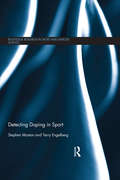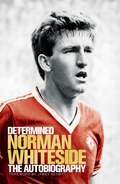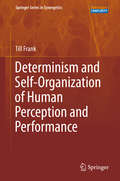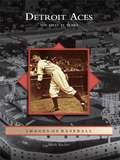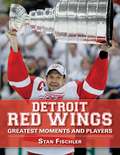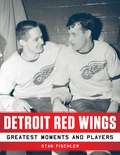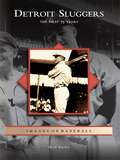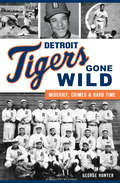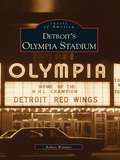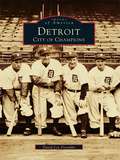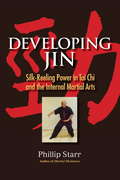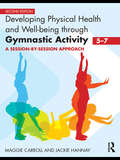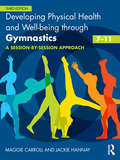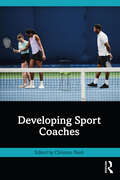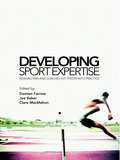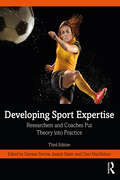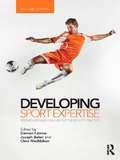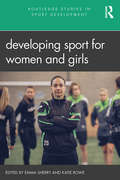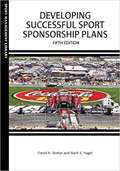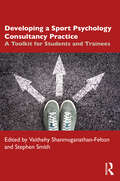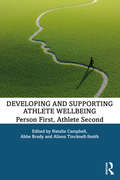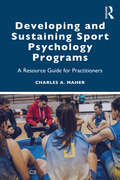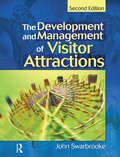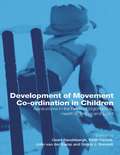- Table View
- List View
Detecting Doping in Sport (Routledge Research in Sport and Exercise Science)
by Stephen Moston Terry EngelbergThe book explores the changing landscape of anti-doping investigations, which now largely centre on the collection of intelligence about doping through processes such as surveillance, interviews with witnesses and interrogation of athletes. It examines why and how investigative processes, hitherto typically reserved for serious crimes, have been co-opted by anti-doping agencies into a situation where their potential for harm has received little or no critical consideration. This book highlights the opportunities and threats inherent in adopting new investigative processes. It is expected that many of the same problems that have engulfed forensic investigations over the last two decades, such as miscarriages of justice, are likely to surface in future anti-doping investigations. Drawing on empirical research and theory from a range of disciplines, including: forensic psychology, criminology, policing, law, sports management and policy studies, this book fills a scholarly vacuum on the investigation of doping through non-biological detection methods.
Determined: The Autobiography
by Norman WhitesideNorman Whiteside is more than a cult hero to Manchester United fans. In his eight years with the club he came to embody their aspirations to such an extent that he was embraced as their on-field representative, the supporter on the pitch. In this fascinating autobiography, Whiteside reveals the workings of Old Trafford during the 1980s - the good, the bad, the booze and the arrival of Fergie. His stories of growing up in the sectarian violence of Belfast will shock many, whereas the determination he showed when rebuilding his life when his footballing career was destroyed by injury will act as an inspiration. His career is littered with unforgetable moments, among them the astonishing performance of the seventeen-year-old usurper of Pele's 'youngest ever' World Cup record as Northern Ireland beat Spain in Valencia in 1982.
Determined: The Autobiography
by Norman WhitesideNorman Whiteside is more than a cult hero to Manchester United fans. In his eight years with the club he came to embody their aspirations to such an extent that he was embraced as their on-field representative, the supporter on the pitch. In this fascinating autobiography, Whiteside reveals the workings of Old Trafford during the 1980s - the good, the bad, the booze and the arrival of Fergie. His stories of growing up in the sectarian violence of Belfast will shock many, whereas the determination he showed when rebuilding his life when his footballing career was destroyed by injury will act as an inspiration. His career is littered with unforgetable moments, among them the astonishing performance of the seventeen-year-old usurper of Pele's 'youngest ever' World Cup record as Northern Ireland beat Spain in Valencia in 1982.
Determinism and Self-Organization of Human Perception and Performance (Springer Series in Synergetics)
by Till FrankThis book discusses human perception and performance within the framework of the theory of self-organizing systems. To that end, it presents a variety of phenomena and experimental findings in the research field, and provides an introduction to the theory of self-organization, with a focus on amplitude equations, order parameter and Lotka-Volterra equations. The book demonstrates that relating the experimental findings to the mathematical models provides an explicit account for the causal nature of human perception and performance. In particular, the notion of determinism versus free will is discussed in this context. The book is divided into four main parts, the first of which discusses the relationship between the concept of determinism and the fundamental laws of physics. The second part provides an introduction to using the self-organization approach from physics to understand human perception and performance, a strategy used throughout the remainder of the book to connect experimental findings and mathematical models. In turn, the third part of the book focuses on investigating performance guided by perception: climbing stairs and grasping tools are presented in detail. Perceptually relevant bifurcation parameters in the mathematical models are also identified, e.g. in the context of walk-to-run gait transitions. Chains of perceptions and actions together with their underlying mechanisms are then presented, and a number of experimental phenomena – such as selective attention, priming, child play, bistable perception, retrieval-induced forgetting, functional fixedness and memory effects exhibiting hysteresis with positive or negative sign – are discussed. Human judgment making, internal experiences such as dreaming and thinking, and Freud’s concept of consciousness are also addressed. The fourth and last part of the book explores several specific topics such as learning, social interactions between two people, life trajectories, and applications in clinical psychology. In particular, episodes of mania and depression under bipolar disorder, perception under schizophrenia, and obsessive-compulsive rituals are discussed. This book is intended for researchers and graduate students in psychology, physics, applied mathematics, kinesiology, and the sport sciences who want to learn about the foundations of the field. Written for a mixed audience, the experiments and concepts are presented using non-technical language throughout. In addition, each chapter includes more advanced sections for modelers in the fields of physics and applied mathematics.
Detroit Aces: The First 75 Years (Images of Baseball)
by Mark RuckerEver since the city was granted its first major league team, the Wolverines in 1881, Detroit baseball fans have packed the parks to loyally cheer for their favorite hurlers on the mound. In 1887, Charlie Getzein, nicknamed "Pretzels," led the Detroit ball club to its first National League pennant with 29 wins. The rubber-armed "Wild" Bill Donovan led the Detroit Tigers to the city's first American League pennant in 1907, notching up an astounding .862 winning percentage despite a legendary lack of control. More great pitchers were to follow in the coming decades, and, written from the perspective of an old-time fan, Detroit Aces: The First 75 Years is a fun read for any Motor City baseball enthusiast.
Detroit Red Wings: Greatest Moments and Players
by Stan FischlerOne of the National Hockey League's "Original Six," few teams in professional hockey have enjoyed more success than the Detroit Red Wings. In this newly revised edition, Stan "the Hockey Maven" Fischler profiles over fifty of the greatest characters from this unforgettable franchise. Fans can read about everyone from the legendary Gordie Howe (who was almost killed by a body-check that fractured his skull before he went on to become known as "Mr. Hockey") to Nicklas Lindström (who became the first European to win the Conn Smythe Trophy in 2002). With a deft pen, Fischler describes the Red Wings greatest accomplishments from his front-row seat in the press box. Beyond the stats and facts, this veteran sportswriter brings fans off the ice and into the locker room to share a treasure trove of stories and anecdotes from this legendary franchise. Within these pages, fans will taste the adrenaline as the Red Wings rack up 10 Stanley Cup Championships and cheer with the crowd as Pete and Jerry Cusimano toss the first "good luck" octopus onto the ice. Without a doubt, Detroit Red Wings Greatest Moments and Players is a must-have for any Red Wings fan.
Detroit Red Wings: Greatest Moments and Players
by Stan FischlerOne of the National Hockey League’s “Original Six,” few teams in professional hockey have enjoyed more success than the Detroit Red Wings. In this newly revised edition, Stan “the Hockey Maven” Fischler profiles more than fifty of the greatest characters from this unforgettable franchise. Fans can read about everyone from the legendary Gordie Howe (who was almost killed by a body-check that fractured his skull before he went on to become known as “Mr. Hockey”) to Nicklas Lindström (who became the first European to win the Conn Smythe Trophy in 2002). With a deft pen, Fischler describes the Red Wings' greatest accomplishments from his front-row seat in the press box. Beyond the stats and facts, this veteran sportswriter brings fans off the ice and into the locker room to share a treasure trove of stories and anecdotes from this legendary franchise. Within these pages, fans will taste the adrenaline as the Red Wings rack up eleven Stanley Cup Championships and cheer with the crowd as Pete and Jerry Cusimano toss the first “good luck” octopus onto the ice. Without a doubt, Detroit Red Wings: Greatest Moments and Players is a must-have for any Red Wings fan.
Detroit Sluggers: The First 75 Years (Images of Baseball)
by Mark RuckerEver since the city was granted its fi rst major-league team, the Wolverines in 1881, Detroit baseball fans have packed the parks to loyally cheer for their favorite sluggers at the plate. Big Dan Brouthers helped the Detroit ball club win its first National League pennant with 12 home runs, 101 RBIs, and a league-leading 153 runs scored in 1887. Twenty years later, a rookie named Ty Cobb, at the start of a hall-of-fame career, led the league in batting and the Tigers to three successive American League pennants. Hank Greenberg, Rudy York, and Al Kaline joined the ranks of Motor City sluggers in the coming decades who thrilled fans with the long ball in pennant race after exciting pennant race. Written from the perspective of an old-time fan, Detroit Sluggers: The First 75 Years is a fun read for any Motor City baseball enthusiast.
Detroit Tigers Gone Wild: Mischief, Crimes and Hard Time (Sports)
by George HunterThe Detroit Tigers came out of the womb scratching and snarling. Early owner James D. Burns orchestrated the only known arrest of a journalist while covering a game. It's the only Major League franchise to sign a star player out of prison, which happened twice. Ex-Tigers have done time for crimes ranging from armed robbery to racketeering-and worse. One tried to burn and dismember a group of men after they kidnapped his mother. Another threatened to blow up a cruise ship unless he was paid a sizeable ransom. And Detroit legend Ty Cobb ran afoul of the law several times during his brilliant, tumultuous and often mischaracterized career. Join Detroit News writer George Hunter on a foray into the darkest, unruliest and sometimes funniest moments in Tigers history.
Detroit's Olympia Stadium
by Robert WimmerAlso known as the Old Red Barn, Olympia Stadium was the largest rink in the United States when it opened in Detroit on October 22,1927. Robert Wimmer has compiled over 200 historic photographs and detailed captions for this new book, that follows the life of a sporting and entertainment landmark in the Motor City until its demolition in 1986. For over half a century, the Olympia Stadium hosted many of the top shows and stars coming through Detroit. The historic landmark filled its seats for the multitude of sporting events in Michigan, including championship boxing, wrestling, and lacrosse, and was also the home of the Detroit Redwings and the Pistons. Although there are many anonymous people pictured here who contributed to the history of the stadium, readers will recognize the more familiar faces and acts of Elvis Presley, the Beatles, the Roy Rogers Rodeo, Dick the Bruiser, and many others.
Detroit: City of Champions
by David Lee PorembaProfessional sports have played an important part in the history of the people and the City of Detroit since the turn of the century. Detroit sports teams have given the city a unique identity and provided the means to gain both a sense of community pride and a unity of spirit. At no other time was this more evident than during the decades from the 1920s through the 1950s, when Detroit teams rose consistently to the top of their individual professions. In 1935, the three professional sports teams in Detroit accomplished a remarkable feat by each winning their respective league titles and going on to capture the World Championships of baseball, football, and hockey, earning for the City of Detroit the honored sobriquet of "City of Champions." Here began a close and lasting relationship between Detroit sports teams and their fans.
Developing Jin
by Phillip StarrDeveloping Jin provides a complete and progressive training regimen for increasing and refining chansi-jin, also known as silk-reeling power or coiling power--the true power of the internal martial arts. With step-by-step instructions and photographs, experienced teacher Philip Starr walks readers through a variety of techniques designed to help practitioners feel and use jin in their martial arts training. While much of the existing writing on jin relies on cryptic and mystical descriptions of internal power, Starr takes a direct, no-nonsense approach that addresses commonly held myths and identifies the real body mechanics behind this unusual power. Useful for novices and advanced practitioners alike, Developing Jin is a crucial addition to any serious martial artist's library.Table of Contents1.Got Jin? 2. How To Use This Book3.Basic Conditioning Exercises4.In The Beginning5.Structure and Alignment6.Training the Breath7.The Nature Of Qi8.Let's Get Engaged!9.Beginning With Stillness10.The Breath Coiling Form11.The Secret Of Tendon Power12.Internal Coiling13.Applying The Coiling Power14.Putting It All Together15.Training Routines For Coiling Power16. Three Become One17. Combative ApplicationsConclusion
Developing Physical Health and Well-Being through Gymnastic Activity (5-7): A Session-by-Session Approach
by Maggie Carroll Jackie HannayHow can you make gymnastics activity fun, lively and inclusive? How can you improve the health and well-being of all your children? How can you ensure progression over time? This practical and easy-to-use teacher’s guide is the brand new edition of the popular workbook Movement Education leading to Gymnastics 4-7. It takes a session-by-session approach to teaching physical development and well-being through gymnastics for the five to seven age range. Fully updated with the most current schemes of work to use at Key Stage 1, it sets out a series of forty sessions over the two year span, to give you planned and logical progression of both content and advice. This one-stop resource includes twenty session plans per year group, which you can follow as a complete course or dip into for ideas and inspiration. It also includes Specific Skills Guide to help you support children in developing the correct techniques. Each session plan includes: learning objectives assessment criteria teaching approaches warm up and cool down activities the content of the session apparatus needed health and safety considerations. The companion volume, Developing Physical Health, Fitness and Well-Being through Gymnastics 7-11 follows the same format, and together, these user-friendly books provide a progressive programme of work from Years 1-6. If you are a practising or student teacher, this guide will give you all the confidence you need to teach gymnastics in your school.
Developing Physical Health and Well-being through Gymnastics (7-11): A Session-by-Session Approach
by Maggie Carroll Jackie HannayHow can you make gymnastics challenging, lively and inclusive? How can you improve the health, fitness and well-being of all your children? How can you ensure progression over time? This practical and easy-to-use teacher’s guide is the brand new edition of the popular workbook Gymnastics 7-11. It takes a session-by-session approach to teaching physical development and well-being through gymnastics for the seven to eleven age range. Fully updated with the most current schemes of work to use at Key Stage 2, it sets out a series of forty-four sessions over the four year span, to give you planned and logical progression of both content and advice. The session plans are structured from year three to year six and can be followed as a complete course or dipped into for ideas and inspiration. Illustrated thoughout with colour photographs of real children in a range of gymnastics lessons, this one-stop resource also includes a 'Specific Skills Guide' to help you support children in developing the correct techniques. Each session plan includes: learning objectives assessment criteria consolidation from the previous session step-by-step session content warm up and final activities teaching approaches floor and apparatus work. The companion volume, Developing Health and Well-being through Gymnastic Activity (5-7) follows the same format, and together, these user-friendly books provide a continuous and progressive programme of work from years one to six. If you are a practising or student teacher, this guide will give you all the confidence you need to teach gymnastics in your school!
Developing Sport Coaches
by Christine NashEvolving from the concept of coach education, which is generally accepted to be the more formal, didactic mode of transmitting information to coaches and prospective coaches, coach development is a relatively new field of research and practice. Developing Sport Coaches is a new text that supports the holistic longterm development of sport coaches as well as help aid existing sport coaches to understand their development. Research in coach learning and coach education has raised important questions about the effectiveness, relevance and value placed on traditional coach education by sport coaches in relation to their practice. The dissatisfaction expressed by many coaches, at all stages of coaching practice, has led to the inception of coach development. This text enables coach development to be studied in higher education institutions as well as enabling organisations to embed coach developers within their organisations. Written for the sport coaching and expanding coach development market, this book will be used by higher education institutions students as both a core and additional text to advance research and knowledge in this area. At the same time, this book is also a useful reading for practising sport coaches, coach developers and organisations who are currently examining their structures and processes to move their coaching provision from a formal coach education delivery to a more bespoke offering.
Developing Sport Expertise: Researchers and Coaches Put Theory into Practice
by Joseph Baker Damian Farrow Clare MacMahonAn athlete’s development from ‘ordinary’ talent to elite accomplishment in sport is a long one. The emergence and fine tuning of high level sport skills takes place in increments over many years and is a journey that fascinates sport scientists, sports coaches and sports fans alike. Developing Sports Expertise, the first available textbook for undergraduates in sports skills development, examines the science behind sports skill acquisition and explores the application of science to optimal sports training, and talent identification. The text also contains Coaches Corner insets throughout to provide effective day-to-day advantage based on in the text. Edited by three of the world’s leading scientists in sports skills acquisition and with contributions from both world class coaches and cutting edge researchers, this textbook provides comprehensive, authoritative guide to the field.
Developing Sport Expertise: Researchers and Coaches Put Theory into Practice
by Joseph Baker Damian Farrow Clare MacMahonThe athlete development process spans from initial sport engagement to elite-level performance to effective career transition out of sport. This is a long and complicated process. Identifying and nurturing talent, fine-tuning sport skills, and maintaining high levels of performance over the course of a career requires many thousands of hours of training and, increasingly, the input and support of expert coaches and sport scientists. In this fully revised and updated new edition of the leading student and researcher overview of the development of sport expertise, a team of world-class sport scientists and professional coaches examine the fundamental science of skill acquisition and explore the methods by which science can be applied in the real-world context of sport performance. This book surveys the very latest research in skill acquisition, provides a comprehensive and accessible review of core theory and key concepts, and includes an innovative "Coach’s Corner" feature in each chapter, in which leading coaches offer insights from elite sport and critique contemporary practice in sport skill development. The third edition of Developing Sport Expertise will be invaluable reading for all researchers and students in the areas of expertise in sport, skill acquisition, motor control and development, sport psychology, or coaching theory and practice.
Developing Sport Expertise: Researchers and Coaches Put Theory into Practice, second edition
by Damian Farrow Clare MacMahon Joe BakerThe development of an athlete from basic performance to elite level of accomplishment is a long and complicated process. Identifying and nurturing talent, developing and fine tuning sport skills, and maintaining high levels of performance over the course of a career requires many thousands of hours of training and, increasingly, the input and support of expert coaches and sport scientists. In this fully revised and updated new edition of the leading student and researcher overview of the development of sports expertise, a team of world-class sport scientists and professional coaches examine the fundamental science of skill acquisition and explore the methods by which science can be applied in the real-world context of sport performance. This book surveys the very latest research in skill acquisition, provides a comprehensive and accessible review of core theory and key concepts and includes an innovative ‘Coaches Corner’ feature in each chapter, in which leading coaches offer insights from elite sport and critique contemporary practice in sport skill development. With new chapters offering more material on key topics such as instruction and observation and expert visual perception, the second edition of Developing Sport Expertise is invaluable reading for all researchers and students in the areas of?expertise in sport, skill acquisition, motor control and development, sport psychology, or coaching theory and practice.
Developing Sport for Women and Girls (Routledge Studies in Sport Development)
by Emma SherryWomen and girls are often excluded from organised sport or face challenges in accessing sport or developing within sport. This is the first book to focus on sport development for women and girls. It provides a theoretical and practical framework for readers in the emerging field of sport development. Developing Sport for Women and Girls examines both the development of sport, and development through sport with expert contributions from Australasia, North America and Europe. It offers critical analysis of contemporary sport development, from high performance pathways to engaging diverse communities to the use of sport to empower women and girls. Each chapter explores various contexts of sport development and sport for development theory with a specific focus on women and girls. It covers key topics such as health, education, sexual orientation and participation across the lifecourse, and features international case studies in every chapter. This is essential reading for students, academics, researchers and practitioners working in the area of sport development or sport management.
Developing Successful Sport Sponsorship Plans
by Mark Nagel David StotlarAcquiring sponsorship agreements that are a good fit for both the sport organization and the corporation is one of the most crucial and challenging aspects of a sport manager’s job. In Developing Successful Sport Sponsorship Plans, 5th Edition, readers will have at their disposal a practical, step-by-step guide to identifying, soliciting, obtaining, and implementing appropriate and lucrative sponsorship opportunities.
Developing a Sport Psychology Consultancy Practice: A Toolkit for Students and Trainees
by Stephen Smith Vaithehy Shanmuganathan-FeltonSport and exercise psychology as a profession is becoming increasingly popular, with a growth in the number of students applying for and studying Undergraduate and Postgraduate degrees in sport and exercise psychology in recent years within the UK and International Higher Education landscape. Developing a Sport Psychology Consultancy Practice: A Toolkit for Students and Trainees provides logistical and practical information about becoming and working as an applied sport psychology practitioner and the critical processes involved in setting up a consultancy practice. The book focuses on three broad areas: Pathways into Applied Sport Psychology Practice Setting up a Sport Consultancy Practice Personal and Professional Development Within these areas, the chapters provide coverage on topics related to UK and International training and qualification routes, setting up, operating and marketing successful consultancy practices, engaging in administrative and quality assurance processes and optimising technology for effective practice. The chapters further focus on the practitioner’s journey of personal and professional development, including the importance of maintaining a healthy work–life balance for mental health, integrating self-care strategies into daily lives, developing cultural competence and engaging in lifelong learning. This book is a valuable resource for students who are considering training as an applied practitioner, including students enrolled on undergraduate and postgraduate Sport and Exercise Psychology, Sport and Exercise Science and Psychology programmes. It is also a vital aid for current trainees and recently qualified Sport and Exercise Psychologists.
Developing and Supporting Athlete Wellbeing: Person First, Athlete Second
by Abbe Brady Natalie Campbell Alison Tincknell-SmithThis pioneering book in elite athlete wellbeing brings together the narratives of athletes and wellbeing practitioners in high-performance sport with cutting-edge theorizing from world-leading academics to explore pertinent mental wellbeing matters that present for elite athletes both during and after their careers. The journey of the elite athlete is considered from entering the high-performance system as a youth performer through to retirement, with contributions illuminating the ways in which mental wellbeing can be impacted – both negatively and positively – through common place experiences. Methods of creating holistic high-performance sports cultures along with common mental wellbeing influencers, such as parents, education, faith, injury and (de)selection are explored, as well as the ramifications of uncommon events on mental wellbeing, such as whistleblowing, legal disputes, psychological disorders and COVID-19. Drawing on this analysis, the book then proffers thought-provoking strategies for how the mental wellbeing of both athletes and staff can be understood, developed and supported, ultimately driving elite sport cultural transformation to put the person first and the athlete second. Each chapter presents the wellbeing experience from the vantage of the athlete or the wellbeing practitioner, followed by an academic unpacking of the situation. This makes the book a must read for students and researchers working in sport coaching, sport psychology, applied sport science or sport management, as well as practitioners interested in facilitating a duty of care for high performing athletes, and working in coaching, sport science support, athlete development programs, NGB policy and administration or welfare services.
Developing and Sustaining Sport Psychology Programs: A Resource Guide for Practitioners
by Charles A. MaherDeveloping and Sustaining Sport Psychology Programs: A Resource Guide for Practitioners outlines a systemic approach to creating comprehensive, sustainable sport psychology programs in professional sports organizations, colleges, universities, and at secondary school levels. Based on the author’s more than 30 years of professional experience, this volume presents a framework that delineates methods for designing, implementing, and evaluating sport psychology programs, discussing topics such as needs assessment and client identification. Featuring real-world experiences and clear, non-technical writing, this step-by-step guide can be applied to a range of sport psychology programs including mental skills, life skills, coach education, leadership training, and team development programs. Developing and Sustaining Sport Psychology Programs details a program development process that has been applied successfully at the professional, collegiate, and secondary school levels over a more than 30-year period. It has contributed to the development of sport psychology programs that have sustained themselves over the course of time and is an essential text for sport psychologists and mental skills coaches at all levels as well as graduate students and other professionals in the field.
Development and Management of Visitor Attractions
by John Swarbrooke Stephen J. PageNow in its second edition, the successful 'Development and Management of Visitor Attractions' has been fully revised and updated to cover the latest issues in this ever-changing area of tourism. New features/topics include:* The Millennium Dome* National Lottery funded projects* International case studies* Updated statistics and examplesThe author examines the factors that contribute to the success of visitor attractions. 'The Development and Management of Visitor Attractions' 2nd Edition, covers every aspect of the process of developing and managing different kinds of attractions. Theories explored throughout the text are illustrated through a range of examples and case studies drawn from a number of countries.
Development of Movement Coordination in Children: Applications in the Field of Ergonomics, Health Sciences and Sport
by Keith Davids Geert Savelsbergh John van der Kamp Simon J. BennettCo-ordination of movement plays a key role in human development and is an important area in sport and health sciences. This book looks in detail at how children develop basic skills, such as walking and reaching for objects, and more complex skills such as throwing and catching a ball accurately or riding a bicycle. Development of Movement Co-ordination in Children is informed by five major theoretical perspectives and are explained in an introductory chapter: * neural maturation* information processing* direct perception* dynamic systems* constraint theory. The international contributions are brought together under the headings of ergonomics, health sciences and sport. Focusing on practical applications, individual chapters cover many different aspects of movement behaviour and development, ranging from children's over-estimation of their physical abilities and the links to injury proneness, to the co-ordination of kicking techniques. Both normal and abnormal development is considered. This text will be of considerable interest to students, teachers and professionals in the fields of sport science, kinesiology, physical education, ergonomics and developmental psychology.
